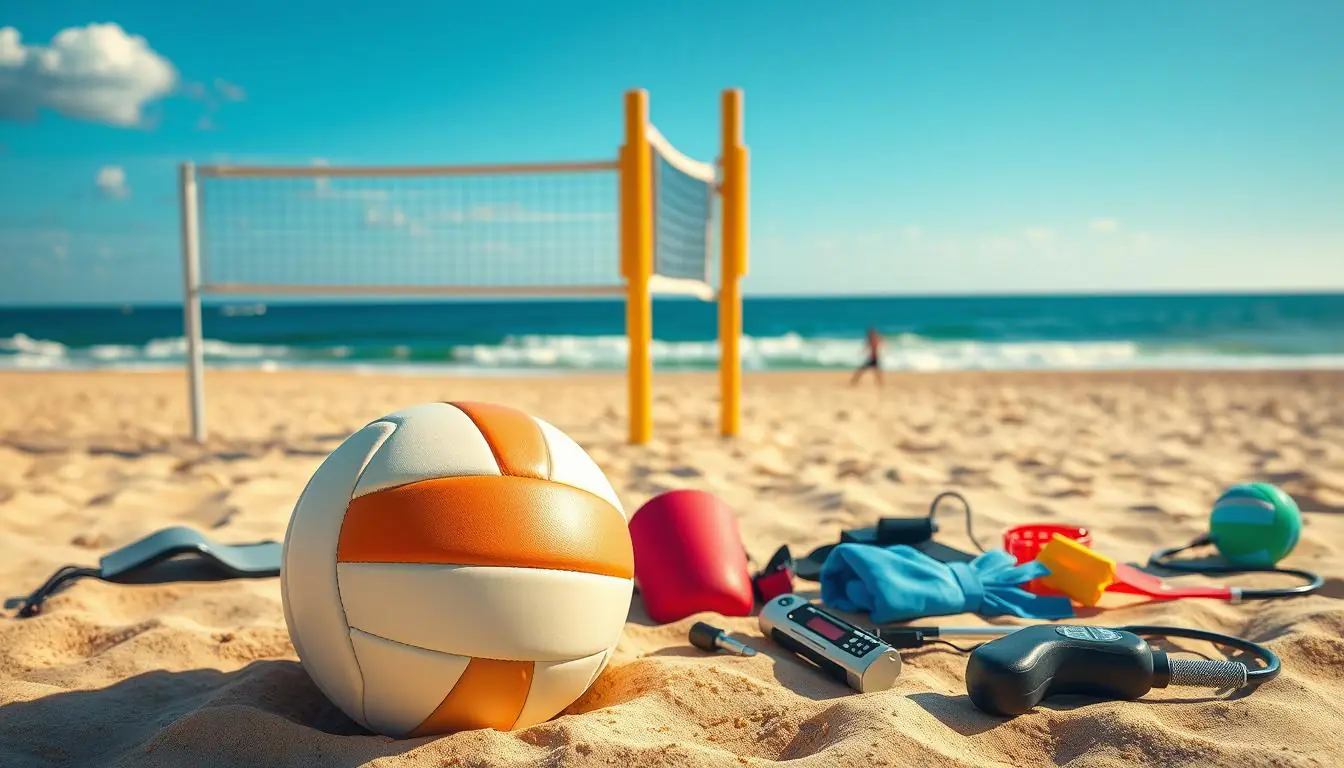Growing up near California’s beaches, I fell in love with volleyball as a teen. The sand, the waves, and the volleyball’s bounce were my summer’s beat. Now, I’m here to guide you in picking the best outdoor volleyballs for fun in the sun.
Looking for a casual game or serious competition? The right volleyballs can make all the difference. They need to handle different surfaces and weather.
This guide covers everything from top-notch to affordable volleyballs. I’ll show you what to look for to improve your game.
Key Takeaways
- Outdoor volleyballs require different construction compared to indoor balls
- Material durability is key for beach and park play
- Professional brands offer specialized outdoor volleyball designs
- Surface type greatly affects ball performance
- Budget and skill level should guide your volleyball choice
Understanding the Essentials of Beach and Park Volleyballs
Choosing the right volleyball for outdoor play is more than just picking any ball. Beach and park volleyballs need special attention for the best play and fun. Let’s explore what makes outdoor volleyballs unique and how to choose the right one.
Official Size and Weight Standards
When it comes to volleyball standards, precision is key. Official beach volleyballs have specific sizes that differ from indoor ones:
- Circumference: 26-27 inches
- Weight: 9.2-9.9 ounces
- Pressure: Between 4.26-4.61 psi
Indoor vs Outdoor Volleyballs: Key Differences
It’s important to know the difference between indoor and outdoor volleyballs. Outdoor volleyballs are made to handle tough conditions:
- Exterior Material: A rougher, more durable surface
- Weight: Slightly heavier for wind resistance
- Color: Brighter for better visibility
Playing Surface Impact on Ball Performance
The surface you play on affects your ball choice. Sand, grass, and hard courts each need specific volleyball traits. Soft surfaces like beach sand require balls with unique bounce and grip compared to firm park grounds.
Choosing the right volleyball is about understanding your environment and playing conditions.
Pro tip: Always check the ball’s specs to make sure it fits your playing surface. The right volleyball can greatly improve your outdoor game.
Top Professional-Grade Outdoor Volleyballs

When looking for professional volleyballs, serious players want the best. The outdoor volleyball market has amazing choices for athletes. They seek tournament-grade balls that can handle tough conditions.
- Molten Elite Beach Volleyball – Official USA Volleyball ball
- Hand-stitched polyurethane cover
- Designed for sand and grass surfaces
- Superior durability for intense gameplay
- Wilson OPTX AVP Official Volleyball
- Official Association of Volleyball Professionals ball
- Made from premium synthetic leather
- Engineered for professional beach tournaments
- Mikasa Beach Pro BV550C
- Debuted in 2022 world finals
- Curved panel design for float serving
- Lightweight and water-resistant
These tournament-grade balls are the best in outdoor volleyball tech. They have special features like better grip, moisture resistance, and the right weight. These help professional athletes perform at their best.
Professional volleyballs are more than just equipment – they’re precision instruments designed for peak athletic performance.
When buying a high-end volleyball, think about the panel, material, and design. These factors are key for your playing environment. Whether it’s sandy beaches or grass courts, these top options will improve your game.
Materials and Construction Technology
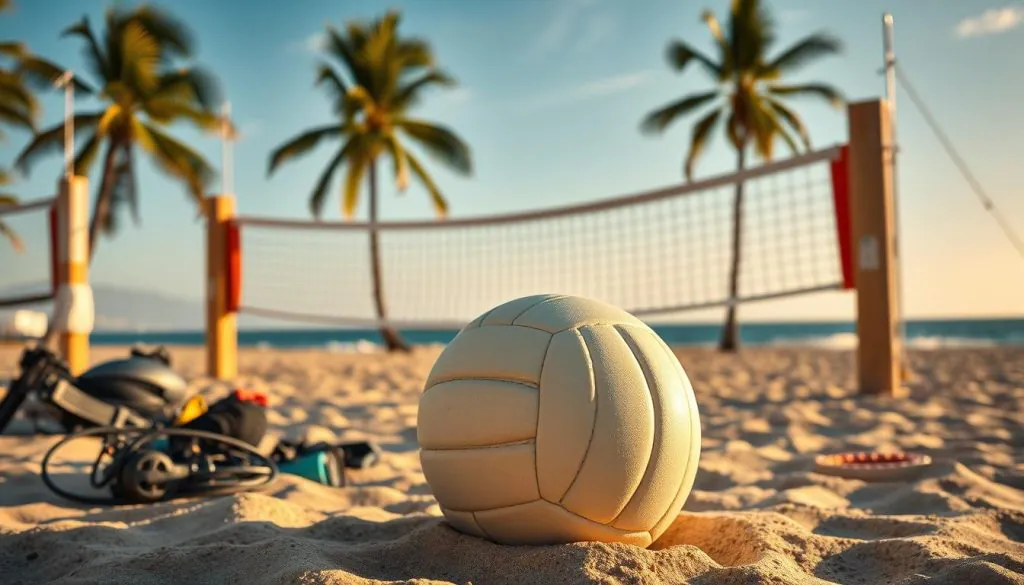
Creating the perfect volleyball involves advanced materials and techniques. Let’s explore the world of volleyball materials and construction. This will help us see how outdoor volleyballs excel.
Cover Materials: Performance Matters
Manufacturers choose between two main cover materials: polyurethane and synthetic leather. Each has its own benefits:
- Polyurethane is tough for outdoor use
- Synthetic leather improves grip and control
- Modern covers also resist moisture
Bladder Types and Air Retention Technology
Air retention is key for volleyball performance. Butyl rubber bladders are the top choice for keeping air in during games.
| Bladder Type | Air Retention Performance | Typical Usage |
|---|---|---|
| Butyl Rubber | Excellent | Professional Outdoor Volleyballs |
| Latex | Good | Recreational Volleyballs |
| Synthetic Composites | Very Good | Competition-Level Balls |
Panel Construction and Stitching Methods
Panel design affects how the ball flies and stays stable. Professional volleyballs usually have:
- 8-panel designs for indoor play
- 10-panel designs for beach volleyballs
- Strong stitching for longer life
Knowing these details helps players choose the right volleyballs for outdoor play.
Best Budget-Friendly Outdoor Volleyballs
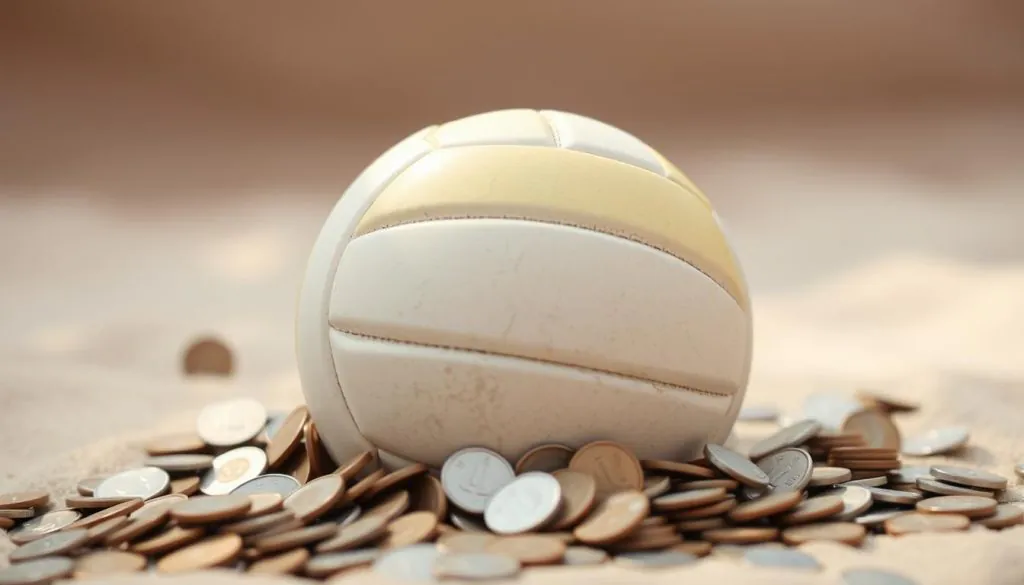
Finding affordable volleyballs doesn’t mean you have to sacrifice quality. I’ve looked into the best budget volleyball options for outdoor play. These volleyballs are perfect for casual players or beginners, giving great performance without costing too much.
Here are some top picks that are easy on your wallet:
- Mikasa Beach Classic Super Soft: Best for beginners
- Price range: $18.00 to $35.00
- Foam layer under cover for extra comfort
- Ideal for recreational players
- Wilson Cast Away: Affordable outdoor option
- Price range: $21.00 to $29.00
- Durable design for park and beach games
If you want professional-level performance without spending a lot, check out these options:
| Volleyball Model | Price Range | Key Features |
|---|---|---|
| Molten BV5000 Elite | $40.00 – $64.00 | Competition-grade, excellent outdoor performance |
| FIVB Approved Beach Volleyball | $44.00 – $69.99 | Tournament-standard quality |
“Great volleyball doesn’t have to cost a fortune. It’s about finding the right balance between quality and affordability.” – Volleyball Enthuasiast
Pro tip for those on a budget: Buying in bulk can save you money. You can call volleyball suppliers at 1-800-494-3933 for special deals. The right ball can really enhance your outdoor volleyball experience.
Water Resistance and Durability Features
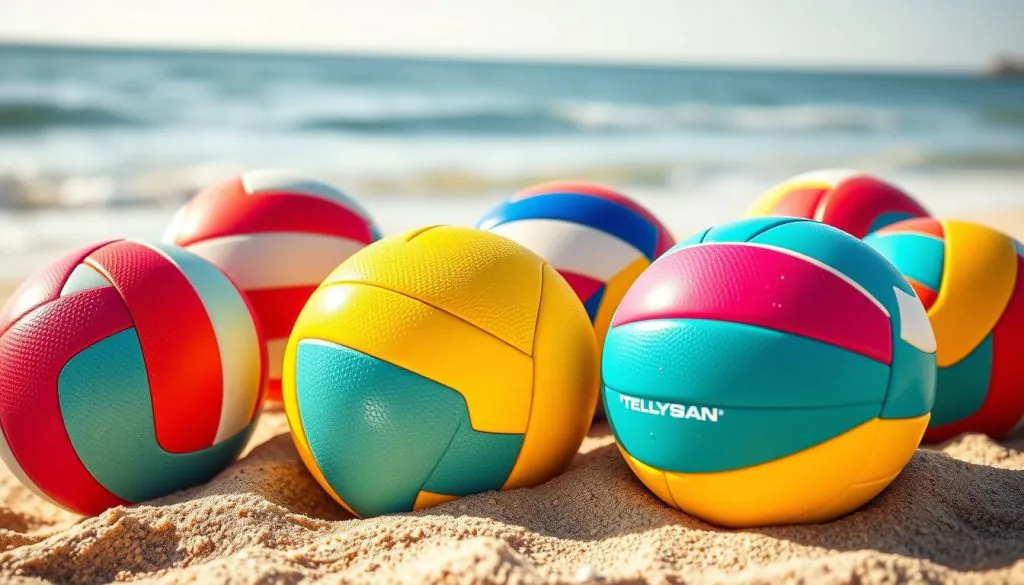
Outdoor volleyball needs balls that can handle the weather. Balls must be tough against the sun and rain.
Top waterproof volleyballs have special tech for all weather. Let’s look at what makes them stand out:
Weather-Proof Coatings
Modern volleyballs have coatings that keep water out. For example, the Mikasa VLS300 has a cover that keeps water away. This helps the ball stay the right weight during play.
- Advanced polyurethane protective layers
- Specialized hydrophobic treatments
- Enhanced grip in wet conditions
Sand and Moisture Protection
Balls need to keep sand and water out. The Mikasa Beach Volleyball BV550C has a special valve. It keeps sand and water out, protecting the ball.
UV Resistance Properties
The sun can damage volleyballs. The Molten BV5000 has UV-protective coatings. These coatings stop colors from fading and materials from breaking down.
Professional athletes rely on volleyball technology that maintains performance across challenging environments.
Choosing the right waterproof volleyball is key. It prepares you for any outdoor game, from beach to park.
Premium Volleyball Brands and Their Signatures
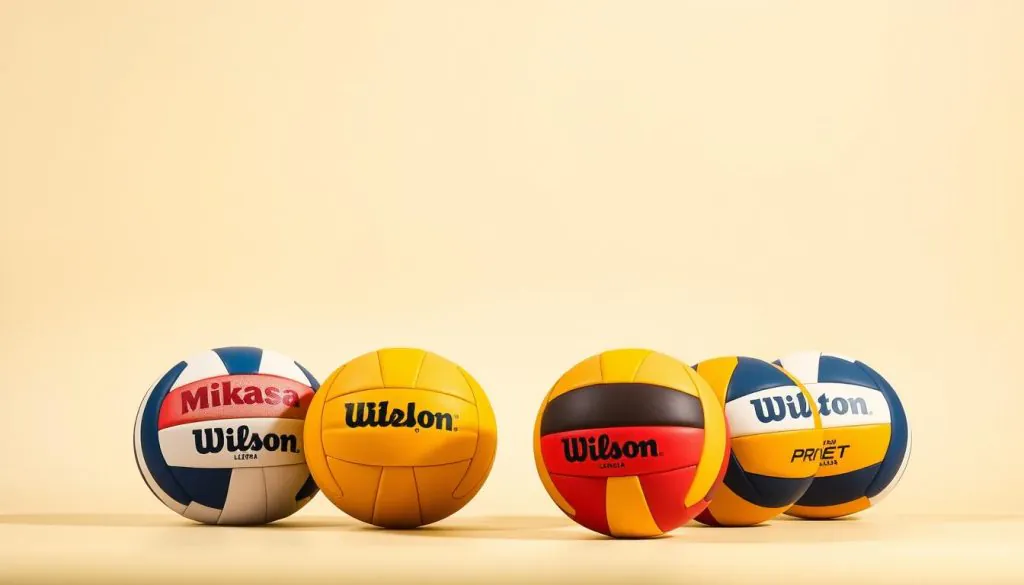
When we look at top volleyball brands, Molten, Wilson, and Tachikara are at the forefront. Each brand has unique features that make them stand out.
Tachikara leads in volleyball equipment, with models like the SV5W and VB7500. The VB7500 Outdoor Volleyball is great for many surfaces, including cement. It has a durable leather exterior and is balanced for hitting and passing.
- Durable leather exterior
- Optimal firmness for hitting
- Soft touch for precise passing
- Multiple color options for team customization
Wilson and Molten are also top brands. They’re known for their high-quality volleyballs. These brands focus on design and performance.
For those who play in tournaments, these brands have NFHS-certified volleyballs. These meet strict standards. Each brand makes slight changes to improve the player’s experience.
Choosing the right volleyball brand isn’t just about reputation—it’s about finding the perfect match for your playing style and environment.
My advice? Try out different brands to see which one fits your game best. Knowing the differences can really improve your game.
Spin Technology and Visual Design Elements
![]()
Volleyball design has changed a lot in recent years. Now, players see the ball in a new way during games. The look of volleyballs today is more than just style – it’s key for better play.
Today’s volleyballs have special features to help players see the ball better. Spin tracking technology is a big change in volleyball gear.
Color Patterns for Enhanced Visibility
Modern volleyballs aim to improve how players see the ball. They use colors in a smart way. This helps athletes:
- See the ball’s spin better
- Guess where the ball will go
- Stay focused during long games
Professional Tracking Systems
Top volleyballs, like the Wilson OPTX AVP Official Beach Volleyball, have the latest spin tracking. These volleyballs have:
- Optic Flow graphics for better tracking
- Colors that stand out
- Textures that show ball movement
| Volleyball Model | Visibility Features | Price |
|---|---|---|
| Wilson OPTX AVP | Optic Flow Graphics | $49.99 |
| Mikasa Beach Classic | High-Contrast Coloration | $35.00 |
| Molten BV5000 Elite | Spin Tracking Surface | $64.00 |
Professional players know that design is more than looks. It’s a big help in improving their game.
Comfort Features for Recreational Players
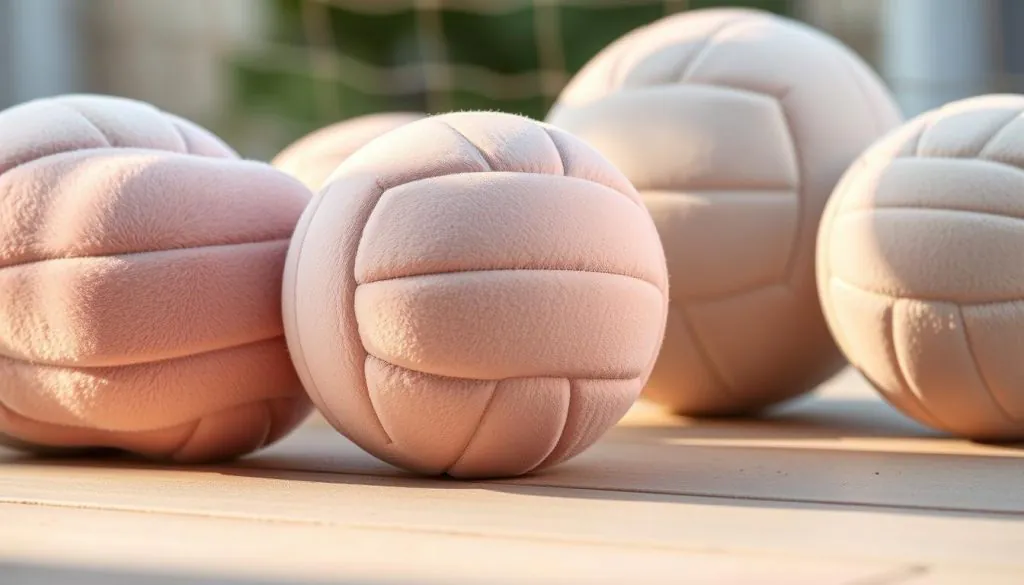
Recreational volleyball players need gear that makes the game fun and comfy. Soft volleyballs have changed how casual players enjoy the game. They offer a softer touch and less impact during play.
When picking volleyballs for a comfy game, look for these features:
- Soft-touch cover materials that reduce hand fatigue
- Foam-backed surfaces for less sting during hits
- Lightweight designs for better recreational volleyball features
- Cushioned panels for better grip and comfort
The best volleyballs for casual play focus on comfort without losing performance. The Chance Soft Training Volleyball is a great example. It has a sponge-backed cover for a great feel for casual players.
| Volleyball Type | Comfort Features | Best For |
|---|---|---|
| Soft Training Volleyball | Sponge-backed cover | Beach and park games |
| Recreational Foam Volleyball | Extra cushioning | Family gatherings |
| Lightweight Outdoor Volleyball | Reduced impact design | Casual player groups |
For players wanting a comfy game, look for volleyballs with special features. These features protect against hand strain and offer a softer play. Such volleyballs make games more fun and accessible for all.
Tournament-Approved Outdoor Volleyballs
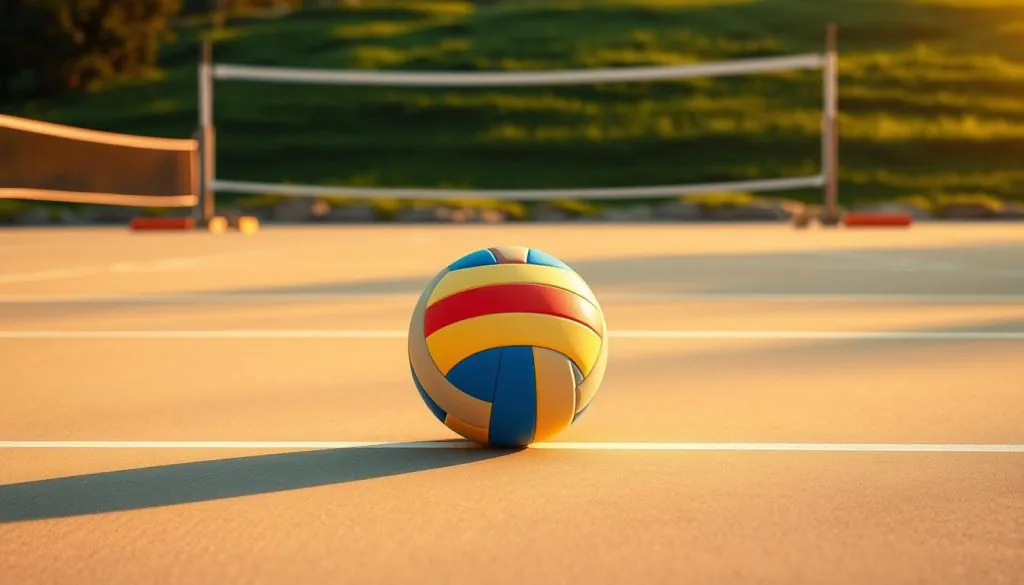
For serious volleyball, not just any ball will do. Official volleyball models must meet strict standards set by international bodies. I’ll explain what makes a volleyball competition-grade and FIVB approved.
Professional players know the right volleyball is key for tournament play. The International Volleyball Federation (FIVB) has strict rules for official volleyballs in competitive events.
Competition Volleyball Specifications
Competitive volleyballs have to meet exact technical standards:
- Specific circumference measurements
- Precise weight requirements
- Regulated air pressure
- Approved material composition
FIVB Approved Models
Here’s a list of top volleyballs that meet international standards:
| Volleyball Model | Price Range | FIVB Status |
|---|---|---|
| Molten BV5000 Elite | $40.00 – $64.00 | Approved |
| Mikasa Beach Volleyball BV550C | $68.00 | Official FIVB Game Ball |
| Molten V5B5000 | $44.00 – $69.99 | Olympic Games Official Ball |
Choosing the right volleyball is more than just meeting specs. Professional players know the right ball can significantly impact performance and game experience.
Key Considerations for Tournament Play
- Verify FIVB certification
- Check material durability
- Test air pressure consistency
- Evaluate surface texture
Whether for a local tournament or professional competition, knowing these standards helps make a smart choice.
Maintenance and Care Tips for Outdoor Volleyballs
Keeping your outdoor volleyball in good shape is key to making it last longer. It’s not just about playing. It’s about taking care of it so it stays in top condition.
Here are some important tips for keeping your ball in great shape:
- Clean your volleyball after each use with a soft, damp cloth
- Remove sand and dirt carefully to prevent surface damage
- Store the ball in a cool, dry place away from direct sunlight
- Avoid extreme temperature variations
It’s important to check the ball’s pressure before playing. The recommended internal pressure ranges between 0.6 – 1.1 kgf/cm², depending on the ball size.
When you inflate, use glycerin on the needle. This helps prevent damage to the valve. It’s a small step that can make a big difference in how long your volleyball lasts.
Pro tip: Invest in a quality air pump with a pressure gauge to ensure consistent inflation.
Regular checks can help spot problems early. Look out for signs like:
- Loose stitching
- Surface cracks
- Loss of air pressure
- Reduced bounce performance
By following these tips, you’ll keep your volleyball in great shape. This means you can enjoy playing in beach and park settings without worry.
Price Range and Value Comparison
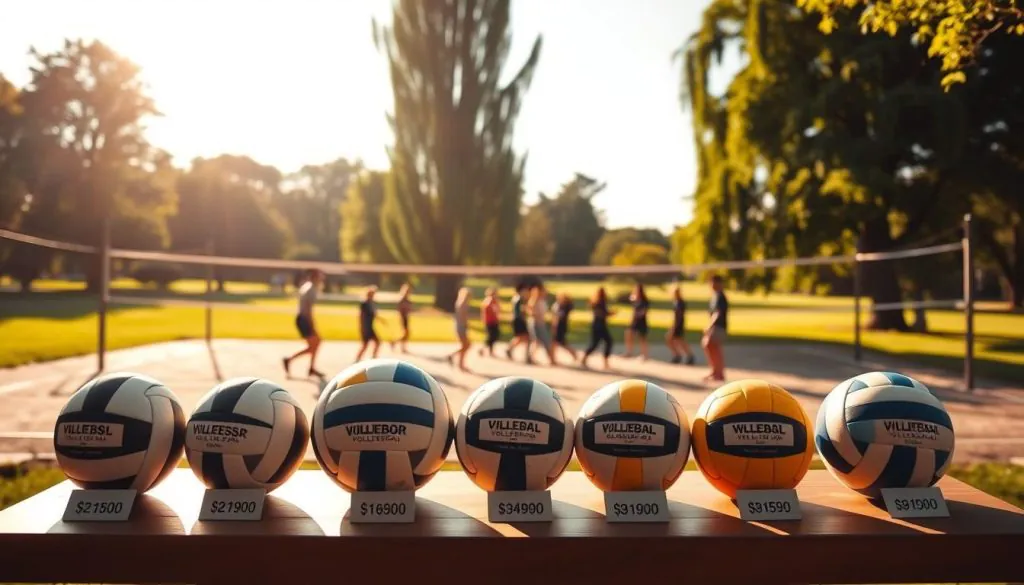
Finding the right volleyball can be tough, whether you play for fun or seriously. Outdoor volleyballs come in many prices, fitting different budgets and playing styles.
Prices vary from affordable to high-end. Basic volleyballs cost $15-$20, while top models can be over $70. Here are some key price points to help you find great value:
- Budget Range ($15-$30): Perfect for casual players and newbies
- Wilson AVP Soft Play Volleyball
- Champion Sports Rubber Volleyball
- Mid-Range ($30-$50): Good for regular players
- Mikasa Miramar King of the Beach Volleyball
- Runleaps Outdoor Volleyball
- Professional Range ($50-$70+): For top tournament performance
- Molten Elite Volleyballs
- Tachikara SV-5W GOLD
When comparing costs, think about more than just the price. Durability, material, and use are key to finding good value. A more expensive ball might last longer and play better.
Pro tip: Buying in bulk can save money for teams or players who play often.
Choose a volleyball that fits your needs. Whether you play casually or competitively, invest in quality that suits your level and play frequency.
Conclusion
Exploring outdoor volleyballs shows it’s more than just buying a ball. Your guide should look at playing surface, skill level, and use. The best balls make playing more fun.
Choosing the right volleyball depends on where you play. Beach balls are bigger, with 26-27 inch circumferences. They need different handling than indoor balls. Two-player teams must handle wind, sunlight, and sand well.
My advice changes based on your playing level. Recreational players want durable, comfy balls. Competitive players need precise spin and weather-resistant balls. The right ball balances performance and your style, whether on sand or grass.
Your perfect volleyball should match your love for the game. From Olympic matches to local tournaments, the right ball changes your game. Choose a volleyball that boosts your performance and enjoys the outdoor challenges.
FAQ
What’s the difference between indoor and outdoor volleyballs?
Outdoor volleyballs are made to handle tough weather like sand and sun. They have strong covers and stitching. They work well on sand or grass, unlike indoor balls for smooth courts.
How do I choose the right volleyball for beach play?
For beach volleyball, look for balls with special coatings and materials. They should have soft covers to reduce sting. Make sure they meet official size and weight standards. Brands like Mikasa and Wilson are great choices.
What should I look for in a volleyball’s construction?
Look at the cover material, bladder type, and stitching. Choose balls with strong panels and consistent air pressure. They should work well in different weather.
How often should I replace my outdoor volleyball?
A good outdoor volleyball can last 1-2 seasons with care. Watch for wear, air loss, and performance drop. It’s time to replace it then.
Are expensive volleyballs always better?
No, not always. While pro-grade volleyballs are top-notch, mid-range ones are great for casual players. Think about your skill and play frequency when choosing.
How do I protect my volleyball from sun and water damage?
Choose volleyballs with sun and water protection. Clean and dry it after play. Store it in a cool, dry place away from sunlight.
What are the official volleyball size and weight standards?
Official volleyballs weigh 260-280 grams and are 65-67 cm in circumference. Outdoor balls might vary slightly, but most meet these standards.
Can I use the same volleyball for different playing surfaces?
While some volleyballs are versatile, it’s best to use surface-specific ones. Beach balls are different from grass or park balls. Each is made for its surface.
How important is ball visibility during play?
Visibility is key for following the ball. Modern volleyballs have colors and designs for better visibility. Bright colors help players track the ball better.
What brands are most trusted for outdoor volleyballs?
Top brands include Mikasa, Wilson, Molten, and Franklin. Each offers something special for different players. Mikasa and Molten are favorites among pros for their quality.
